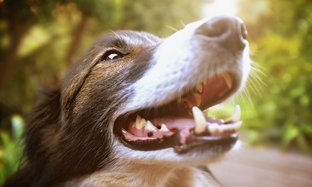
The Ultimate Guide for Dog Teeth Cleaning
As a devoted dog owner, you cherish every moment spent with your furry companion. Your dog's happiness and well-being are of the utmost importance, and that includes their dental health. Neglecting your dog's teeth can lead to a range of issues, from bad breath to severe dental problems that can impact their overall health. Let us understand the importance of dog teeth cleaning and listed below are a few valuable tips to ensure your four-legged friend's dental hygiene is in top shape.
Understanding the Significance of Dog Teeth Cleaning
Just like humans, dogs can suffer from a variety of dental issues, including plaque build-up (which is the yellowish deposits on the teeth surface comprising of food remnants and bacteria), tartar accumulation (i.e hardened plaque), gingivitis (infection that reaches into the gums), and even periodontal disease (severe dental disease affecting the teeth and gums). If left unattended, these problems can escalate, leading to tooth decay and, in some cases, tooth loss.
Beyond the immediate oral consequences, dental issues can also impact your pet's overall health. These problems may affect vital organs like the heart, liver, and kidneys, potentially leading to severe health complications.
Moreover, a dog's mouth is its primary tool for exploring the world. If dental pain hampers their ability to enjoy their environment, it could lead to changes in behavior, such as decreased playfulness or even aggression. Bad breath and unsightly discoloured teeth can also be unpleasant for both you and your guests. It is thus evident that dog teeth cleaning is crucial for their well-being and happiness.
Brush Your Dog’s Teeth
When it comes to dog teeth cleaning, brushing your dog's teeth is one of the most effective ways to prevent dental problems. Aim to brush their teeth at least two to three times a week using a soft-bristled toothbrush and dog-specific toothpaste. Always avoid human toothpaste, as it can be toxic to dogs. Introduce the toothbrush and toothpaste gradually, making it a positive experience for your dog. It is ideal to introduct brushing as early in life as possible so that your dog gets easily accustomed to this routine.
More Tips for Proper Dog Dental Hygiene
- Regular Dental Check-ups: Just as you schedule dental check-ups for yourself, your dog needs them too. Your veterinarian can perform thorough dental examinations and identify potential issues early on. They may also recommend specific dental care product or necessary treatments, such as teeth cleaning or extractions.
- Dental Chews: Dental chews are a great addition to your dog's oral care routine. Look for products designed to promote dental health, like VeggiedentTM FR3SH® Dental Chews for Dogs. These chews contain innovative FR3SH® Technology, which reduces tartar and plaque, freshens breath, and even supports proper digestion that often contribute to bad breath. Plus, they are plant-based, low on calories, gluten-free, easily digestible and make for a great treat!
- Dental Toys: There are dental toys specifically crafted to address your dog's oral health needs. These toys often have textured surfaces that help remove plaque as your dog chews on them. Ensure you supervise your dog while they play with these toys to prevent accidental swallowing of small pieces.
Be mindful that several of the dental chews or dental toys are not recommended for puppies.
- Provide a Healthy Diet: Your dog's overall health is closely linked to their dental well-being. Feeding them a diet high in protein and low in carbohydrates can reduce the risk of plaque build-up. Avoid sugary or high-carb foods, and always ensure they have access to fresh water to prevent dry mouth, which can contribute to dental issues.
- Watch for Signs of Dental Problems: Even with a proactive approach, dental issues can still arise. Keep an eye out for signs such as bad breath, loose or missing teeth, red or swollen gums and difficulty eating. If you notice any of these symptoms, contact your veterinarian promptly for assessment and treatment.
Bottomline
Dog teeth cleaning is a crucial aspect of responsible pet ownership. By prioritizing your dog's dental hygiene and establishing dog teeth cleaning routine, you can enhance their overall health and ensure they enjoy a happier and more comfortable life. Regular checkups, brushing your dog’s teeth, dental chews, appropriate toys, a healthy diet, and vigilance for signs of dental problems are your keys to success. Do not forget to incorporate high-quality dental chews like VeggiedentTM FR3SH® into your routine to provide dental plus digestive health and a breath of fresh air for your beloved canine companion. Your dog will thank you with a lifetime of smiles and tail wags.
1. Can dogs develop cavities like humans?
Dogs can develop dental problems, but cavities are rare compared to humans. Their diet, mouth shape, and oral bacteria differ, reducing the likelihood of decay. However, plaque and tartar buildup can lead to gum disease and other dental issues, making dog teeth cleaning essential.
2. Why is it important to clean my dog's teeth?
Regular dog teeth cleaning helps prevent plaque, tartar, bad breath, gum disease, and potential tooth loss. Poor oral hygiene can also lead to infections that may affect the heart, kidneys, and liver.
3. How often should I brush my dog’s teeth?
Ideally, you should brush your dog's teeth daily, but if that’s not possible, aim for at least three times a week. Regular cleaning ensures plaque doesn’t harden into tartar, which is harder to remove.
4. At what age should I start cleaning my dog's teeth?
Start dog teeth cleaning when your puppy is around 8 to 12 weeks old. Early introduction makes it easier for them to get used to the routine and prevents future dental issues.
5. What kind of toothbrush should I use for my dog?
Use a dog-specific toothbrush with soft bristles. Finger brushes or double-ended toothbrushes designed for different mouth sizes work best. Avoid human toothbrushes, as they may be too harsh for your pet's gums.
6. Can I use human toothpaste for my dog?
No, human toothpaste contains fluoride and xylitol, which are toxic to dogs. Always use dog-safe toothpaste that is specially formulated for them.
7. How do I train my dog to let me brush their teeth?
Start slow and make the experience positive. Let your dog sniff the toothbrush and toothpaste before gently touching their teeth. Gradually increase the brushing time while offering praise and rewards. A guide for dog teeth cleaning can help you follow a step-by-step process.
8. How can I get plaque off my dog's teeth?
Regular dog teeth cleaning with a toothbrush and dog-friendly toothpaste is the best way to remove plaque. Dental chews, water additives, and professional cleanings by a vet can also help maintain oral health.


